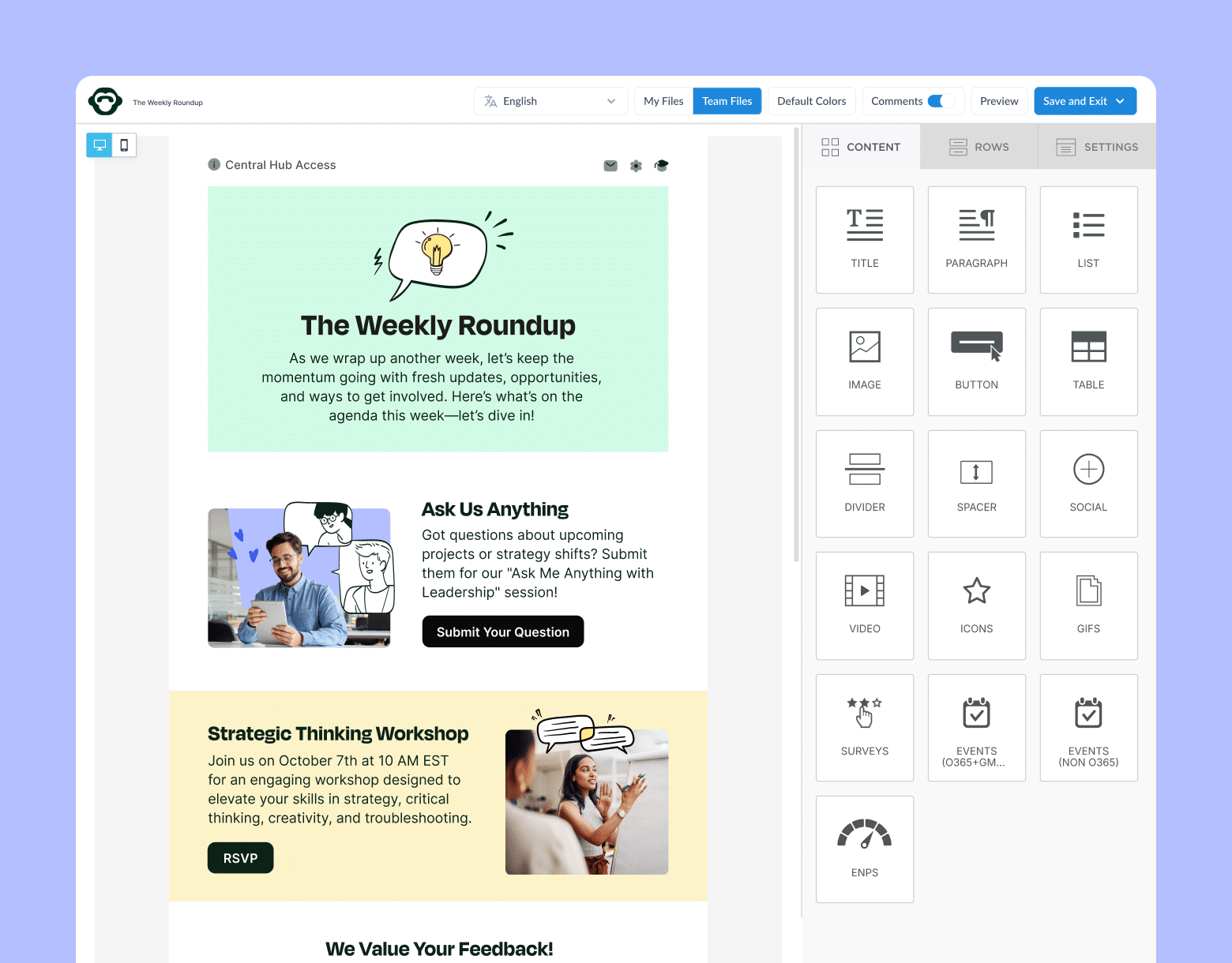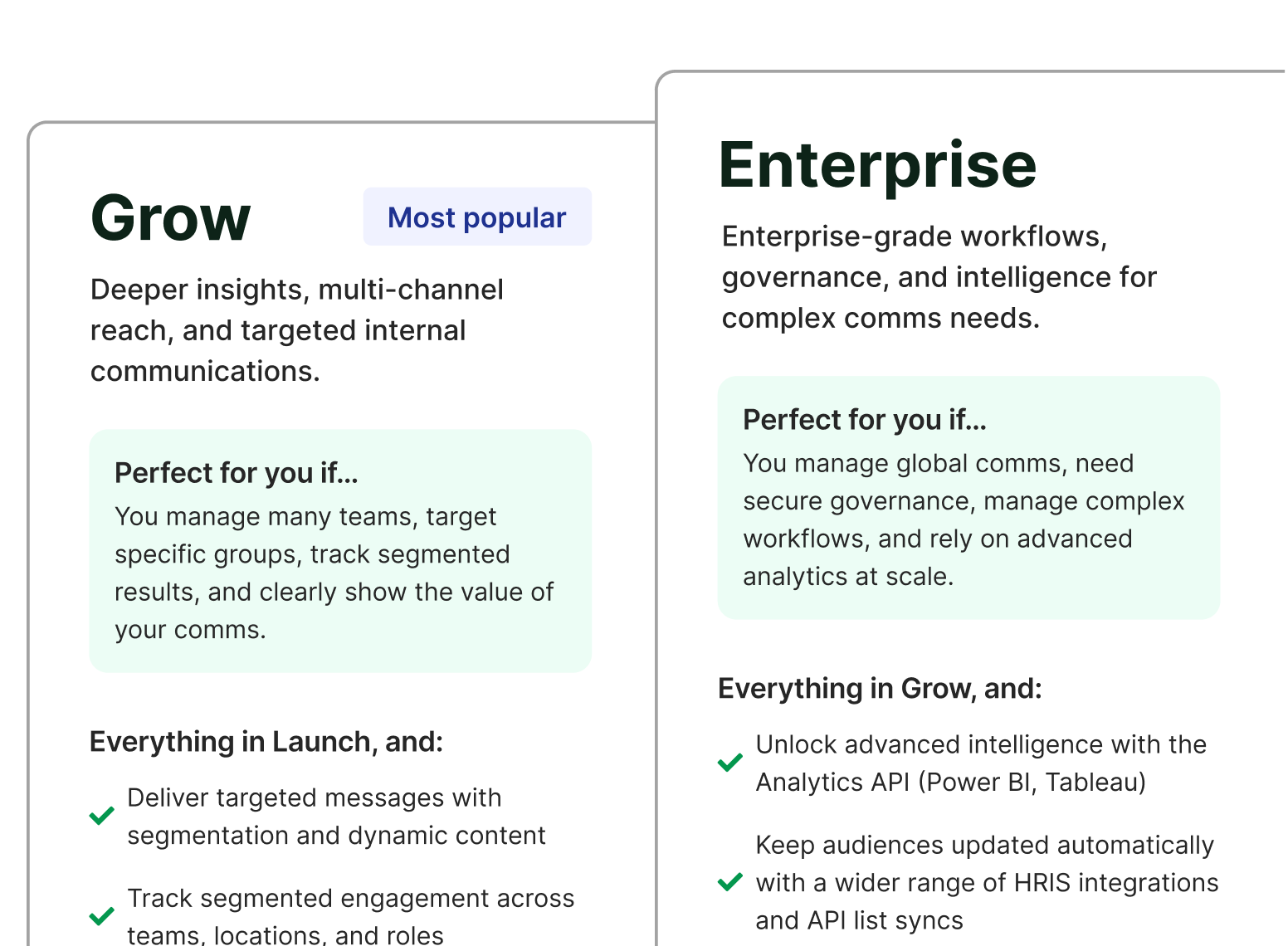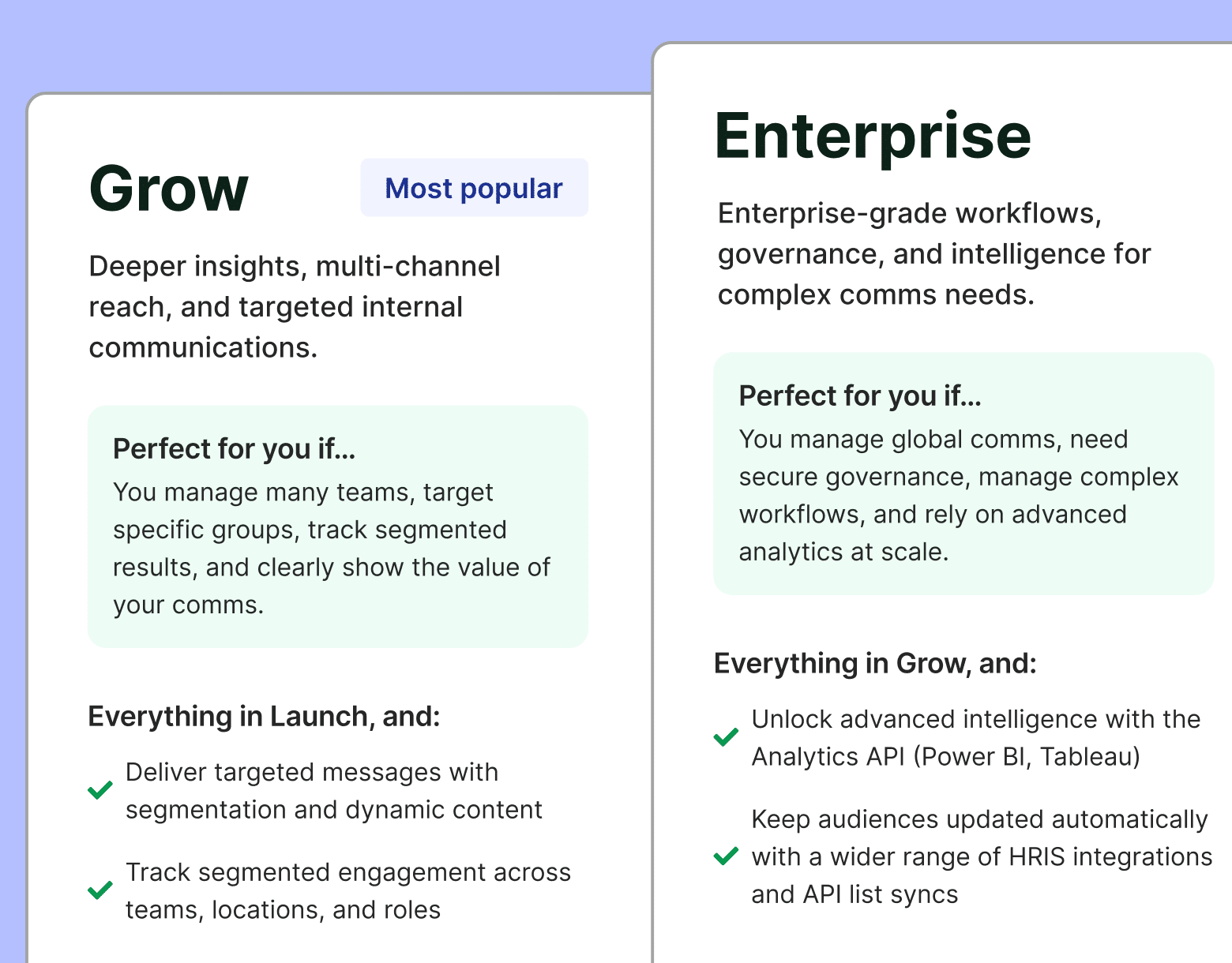If you’re noticing department siloes and reduced productivity, this article is for you. Instead of missing opportunities, learn about the top 10 best internal collaboration tools to build a connected, high-performing workforce.
For every organization, the ability to communicate and collaborate effectively is critical for driving productivity and success. In the absence of internal collaboration, departments operate in isolation, leading to poor communication, a lack of information sharing, and even disengaged employees.
Nowadays, with the rise of remote work and global teams, team collaboration tools have evolved to meet the diverse needs of businesses, enabling teams to stay more connected while streamlining workflows.
From instant messaging to integrated platforms, discover how our top 10 best internal collaboration tools will transform your internal communication strategy through collaboration and productivity.
Take a self-guided tour of ContactMonkey
See how our key features can streamline your internal communications.
Take product tour

What is Internal Collaboration?
Internal collaboration refers to the ways in which team members within an organization communicate and work together to achieve common goals. Effective internal collaboration is the backbone of any successful business, fostering innovation, efficiency, and a sense of unity among team members. Some examples of internal collaboration include:
- Co-authoring documents or reports
- Sharing project updates and status
- Providing feedback and input on initiatives
- Coordinating schedules and deadlines
- Brainstorming ideas and solutions
- Knowledge sharing and training
When you understand the importance of internal communications, you also understand the power of effective internal collaboration.
Why is Internal Collaboration Important?
Internal collaboration stands as a cornerstone of organizational success, significantly driving productivity, sharpening communication, and fueling innovation across teams. According to Stanford research, working in a collaborative environment makes employees 50% more effective at task completion, while also boosting their engagement and motivation.
Why does internal collaboration matter for organizations though? Investing in better internal collaboration strategies and tools offers numerous benefits to organizations:
- Improved productivity and efficiency: When teams can collaborate effectively, work doesn’t get duplicated, tasks are completed faster, and there’s less time wasted on confusion or misunderstandings.
- Better communication and knowledge sharing: Collaboration platforms make it easier to share information, updates, and institutional knowledge across the company, leading to more informed decision-making.
- Enhanced innovation and problem-solving: Diverse perspectives and open collaboration breed creativity. Teams can crowdsource ideas, provide feedback, and develop innovative solutions together.
- Increased employee engagement: Employees who feel connected, heard, and part of an inclusive collaborative culture tend to be more engaged and motivated.
- Stronger company culture and alignment: Internal collaboration tools promote transparency, facilitate cross-functional teamwork, and help align the entire organization around core values and goals.
According to our 2024 Global State of Internal Communications report:
“Communicators are finding ways to streamline their workflows, opting for multi-channel comms tools that collect the features and resources they require in one place and prevent reduplication of effort.“
While email and intranets are still the mainstream channels, communicators are complementing them with internal collaboration tools that enable more real-time, two-way conversations and information sharing. The ability to consolidate multiple communication needs into integrated platforms appears to be driving some of the adoption of these tools.
However, the relatively small percentages citing primary reliance on team collaboration tools indicate they have not yet overtaken traditional channels. Notably, email for broad organizational communications still remained a central tool for communication teams. We note as well that the steady rise of internal collaboration tools points to an ancillary role that could grow over time as workflows evolve.
Modern internal comms and measurement tools
No design or technical expertise needed. Save time, increase engagement, and dazzle your employees with fun and interactive communications.
Explore all features

10 Best Internal Collaboration Tools to Unlock Productivity
Choosing the right internal collaboration tools can make a significant difference in your team’s productivity.
When selecting the best tools to boost productivity, we used specific criteria to ensure they truly are best-in-class and deliver significant value:
- Comprehensive communication capabilities (chat, video conferencing, file sharing)
- Intuitive user interface for easy adoption
- Robust project management and task-tracking features
- Seamless integration with commonly used business tools and apps
- Strong security and admin controls to protect sensitive information
Here are the top 10 tools that can help you streamline communication and enhance internal collaboration:
1. Slack
Slack is a popular messaging app designed for teams. It offers channels for different topics, direct messaging, and integrations with other tools. Slack’s user-friendly interface and extensive integrations make it an ideal choice for improving internal collaboration.
- Key features: Channels, direct messaging, file sharing, integrations with over 2,000 apps.
- Why it’s great: Slack centralizes communication, allowing teams to chat in real time in a formal and informal way. It’s great for getting quick answers and feedback.
- Use case: Ideal for remote teams needing a central hub for communication and internal collaboration.
Slack has become a go-to internal communication tool, especially for remote teams. Its ability to integrate with various other tools makes it a versatile option for businesses of all sizes.
2. Microsoft Teams
Microsoft Teams is an integrated platform that combines workplace chat, meetings, file storage, and application integration. It seamlessly integrates with Microsoft Office 365, making it a powerful tool for organizations already using Microsoft products.
- Key features: Video conferencing, file sharing, team channels, integrations with Microsoft Office Suite.
- Why it’s great: Microsoft Teams seamlessly integrates with the entire Microsft suite making file-sharing, calling, and chat all interlinked and collaborative.
- Use case: Suitable for larger organizations that require a robust internal collaboration platform.
Microsoft Teams is more than just a chat tool; it’s a full-fledged internal collaboration platform that can handle everything from team meetings to document collaboration.
3. ContactMonkey
ContactMonkey is the leading internal email collaboration software that elevates the design, data, and deployment of internal communications by integrating with Outlook or Gmail. The tool streamlines email communication and tracks engagement while enhancing internal team collaboration through emails that deliver measurably more team interaction.
- Key features: Email tracking, internal email templates, real-time analytics.
- Why it’s great: ContactMonkey helps organizations measure and deliver more effective internal communications, allowing them to engage their workforce and make data-driven people decisions.
- Use case: Perfect for internal communicators looking to improve employee engagement through effective emails and track performance.
PRO TIP: ContactMonkey is also a go-to tool for seamless integration with HRIS and other HR platforms, allowing internal communications to save time (10 hours per week!) and segment their data to offer customized comms for various employee groups.
Watch ContactMonkey LIVE in action
Join live demo

4. Asana
Asana is a project management tool that helps teams organize, track, and manage their work. It’s designed to facilitate internal collaboration by providing a clear overview of tasks, deadlines, and project progress.
- Key features: Task management, project timelines, team collaboration, and integrations with various apps.
- Why it’s great: Asana is loved for its user-friendly interface and advanced automation features, which provide a more streamlined and flexible project management experience compared to its competitors.
- Use case: Ideal for teams working on complex projects with multiple tasks and deadlines.
Asana’s visual project management tools make it easy for teams to collaborate on tasks, track progress, and meet deadlines, improving overall internal team collaboration. It’s also key to implementing a successful internal communication strategy.
5. Trello
Trello uses boards, lists, and cards to help teams organize tasks and projects visually. It’s a flexible tool that can be used for everything from project management to brainstorming sessions.
- Key features: Boards, lists, cards, drag-and-drop interface, integrations with various apps.
- Why it’s great: Trello’s visual interface uses a card-and-board system that makes task management intuitive and accessible. Teams can easily see what tasks need to be done, who’s responsible for each, and how projects are progressing at a glance so they focus on execution.
- Use case: Perfect for teams that prefer a visual approach to task management.
Trello’s simplicity and flexibility make it a popular choice for teams looking to enhance internal collaboration without any over-complication. Internal communicators recommend Trello to overcome internal communication challenges by tapping into the tool as one of the best internal comms solutions.
6. Zoom
Zoom is a video conferencing tool that allows teams to hold virtual meetings, webinars, and video calls. It’s become an essential tool for remote teams and organizations with distributed workforces. Ever since the pandemic, video conferencing for internal communication has become one of the top internal communication trends and most organizations (if not all) take advantage of video meetings to manage remote work.
- Key features: Video conferencing, screen sharing, webinar hosting, breakout rooms.
- Why it’s great: Zoom’s features like breakout rooms, virtual backgrounds, and robust security options allow for tailored, professional interactions. Its ability to integrate with calendars, record meetings, and provide high-quality video and audio has made it a cornerstone for internal collaboration in the remote work era, ensuring that teams stay connected and productive no matter where they are.
- Use case: Ideal for remote or hybrid teams needing a reliable, user-friendly video conferencing solution.
Zoom has revolutionized the way teams communicate, making it easier for remote and hybrid teams to stay connected and improve internal business collaboration.
7. Google Workspace
Google Workspace offers a suite of productivity tools including Gmail, Docs, Drive, and Calendar, all designed to enhance internal collaboration. It’s an all-in-one solution for teams looking to collaborate on documents, manage schedules, and communicate effectively. In fact, companies that use Google Workspace (Google+, Google Groups, and Hangout) are said to be amongst those with outstanding internal communication practices.
- Key features: Document collaboration, cloud storage, integrated communication tools, seamless app integration.
- Why it’s great: Google Workspace integrates an entire suite of productivity tools and applications into a single platform. Teams can efficiently manage their workflows, share information instantly, and maintain communication all in one place.
- Use case: Suitable for organizations that need a comprehensive suite of team collaboration tools.
Google Workspace’s collaborative tools, like Google Docs and Sheets, allow multiple team members to work on documents simultaneously, making it easier to collaborate in real time and improve internal team collaboration.
8. Monday.com
Monday.com is a work operating system that powers teams to run projects and workflows with confidence. It offers customizable workflows and integrations that make it easy for teams to collaborate on tasks and projects.
- Key features: Customizable workflows, automation, project management, and integrations with various apps.
- Why it’s great: With its intuitive interface, Monday.com offers a highly customizable platform where teams can design and automate workflows to match their unique processes, significantly boosting productivity and internal collaboration.
Use case: Ideal for teams looking for a flexible and customizable project management solution.
Monday.com’s versatility makes it a powerful tool for teams that need to manage complex projects with multiple moving parts, ensuring effective internal team collaboration. It can also serve as a valuable tool to help you conduct an internal communications audit.


9. Basecamp
Basecamp is a project management and team collaboration software that helps teams stay organized and communicate effectively. It’s designed to simplify project management by providing a central place for all project-related communication and documentation.
- Key features: To-do lists, message boards, file storage, and project timelines.
- Why it’s great: Basecamp’s all-in-one approach to project management means that teams can access everything they need—from project timelines and to-do lists to message boards and documents—without the hassle of juggling multiple tools.
- Use case: Ideal for teams that need a simple yet powerful project management tool to manage employee engagement campaigns, business launches, marketing projects, etc.
Basecamp’s focus on simplicity and organization makes it a great choice for teams looking to streamline their project management processes and ensure smooth internal collaboration.
10. Dropbox
Dropbox is a file hosting service that offers cloud storage, file synchronization, and personal cloud. It’s designed to make file sharing and collaboration easy and secure, playing a key role in internal collaboration.
- Key features: Cloud storage, file sharing, file synchronization, and integrations with various apps.
- Why it’s great: Dropbox is ideally suited for teams needing to share and collaborate on documents securely. Teams can synchronize their files across multiple devices, ensuring that everyone has secure access to the latest versions of documents remotely.
- Use case: Perfect for teams that need a reliable and secure file-sharing solution.
Dropbox’s robust security features make it a top choice for teams that need to ensure their files are protected while collaborating, thereby securing internal communications and enhancing internal business collaboration.
Ready to Transform Your Internal Collaboration with ContactMonkey?
Each of these hand-picked internal collaboration tools offer unique features to enhance internal collaboration though the best choice depends on your team’s specific needs, workflow, and existing tech stack. Consider factors like ease of use, integration capabilities, and scalability when selecting the right tool for your organization. Our handy Internal Communications Software Buyer’s Guide will help you make the right decision for your team, so take advantage!
By implementing these top internal collaboration tools, you can guarantee that your workforce stays informed, more engaged, and collaborates effectively.
Remember, email is one of the powerful communication channels, so the right internal communications email software can amplify your entire tooling ecosystem and drive business success.
Curious how ContactMonkey can fit into your internal comms plan? Book a free demo to see how our platform can help transform the way your team collaborates.



